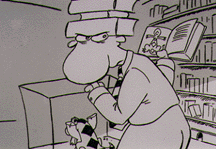Animation
World Magazine, Issue 1.10, January 1997
Confessions of a Festival Juror
by Maureen Furniss
 Maureen
Furniss
Maureen
Furniss
Getting a film or video into a major international
festival like Ottawa is tough. For instance, fewer than one out of 10 films
(approximately 80 out of nearly 1000) submitted to last year's Ottawa International
Animation Festival were selected for the official competition and another
20 or so made it into noncompetitive screenings called panoramas. (Panoramas
generally contain works of interest that are not thought to be "competitive"
for prizes.
Last year, I served on the Ottawa `96 selection committee along with British
2D animator Andy Wyatt and Canadian computer animator/Sheridan College
instructor Stephen Barnes. The three of us began the process of watching
the thousand animated works, ranging from 10 seconds to 30 minutes in length,
beginning Monday, July 8 for 10 hours a day for 5 days and then for 4 hours
a day for another 3 days.
Selective Viewing
We managed to do this, in part, through "selective viewing."
At least half the productions submitted, I would guess, were turned off
before they had ended. Those under five minutes had the best chance of
being seen all the way, though even some of these never made it past the
three minute mark. Time constraints and our desire to showcase only the
most impressive works motivated us to turn off anything that obviously
was not going to make the cut.
Subjectivity played a large part in our decisions, but that subjectivity
was based on years of experience in creating, analyzing and/or teaching
animation. What we "liked" in the screenings was less reflective
of our personal tastes than of some mutually observed standard of "successful"
animation. Although I am usually more drawn to experimental work, there
were straight narrative films I felt very strongly about. Stephen and Andy,
who seem more oriented toward representational images and story lines,
were riveted by more than one abstract, non-narrative film. But despite
all of our differences, the three of us almost always arrived at the same
conclusions about the "competitiveness" of any given work. By
the end of the screening process, we were able to articulate several points
that seemed to characterize the works we watched to the end (and possibly
considered for competition. It is these points which I would like to briefly
summarize, for the benefit of first-time entrants, in particular.
 DaDa by Piet Kroon.
DaDa by Piet Kroon.
One of the most important factors was the first
impression. With a thousand films to watch, improperly cued videos quickly
became irritating (at one point, I proposed that we create a prize for
the best of the color bar formations we sawand heard, with ear-piercing
clarity). Some entries were disqualified simply because we could not find
them on a cassette filled with other titles that were not even entered
in competition. Some entries were preceded by a number of demo-reel items
and we were not sure whether the filmmaker had left them in trying to impress
us, or was just careless. Some people/organizations entered more than one
production and put all of them on one tape. This caused problems when we
wanted to bypass a title and move on to the next one, or to return to it
for a second look. If we could not find something after a few minutes,
we put it aside.
Another important point: do not count on your cassette always remaining
in its box and/or being accompanied by its entry form. We occasionally
had little or no idea what we were watching because a video (particularly
a late entry) was not clearly marked. Each entry should be labeled with
the title, filmmaker's name, country of origin, category and running time.
Also, be sure that you have entered the proper category. I can't tell you
how many productions in the "children's" category were clearly
inappropriate for young viewers (e.g., they depicted children being boiled
or stuck on hooks), how many long films were entered in the short film
category, and so forth. In some instances, films well over 30 minutes were
submitted, despite the fact that half an hour was the maximum running time
allowed.
 The
Sandman
The
Sandman
Making a Good Impression
You may wonder what harm is done by some of these tactics. Although there
may or may not be any immediate repercussions, the possible long-range
effects of your decision are worth considering. Keep in mind that members
of the selection committee someday may be in a position to hire you, show
your films elsewhere, write about you, or deal with you in other ways on
a professional level. In any case, please remember that it is poor form
to call, write or e-mail the festival director and committee members to
complain if your film was not selected. The person you contact in fact
may have really liked you and your work, and is likely to be offended by
the suggestion that he or she exercised poor judgment.
Part of making a good impression on the selection committee comes with
taking care to create a strong soundtrack. A large number of films submitted
were their incomplete, particularly in regard to audio. With 80 slots to
fill, there was little chance we would consider any production lacking
a soundtrack, no matter who made it or how much "promise" it
seemed to hold. Pay attention to sound design early in the production process,
to assure that visual and aural elements are fully intertwined and of equally
high value. Poorly-recorded sound and unprofessional voice-overs were recurring
problems.
The selection committee agreed that certain signs
could be considered "warnings" of poor quality. First off, there
were the long expository notes or apologies written on a cassette or accompanying
materials. It is not a good idea to apologize for your workif you are worried
about its presentation, you should consider entering it at a later date.
Pointing out the flaws in a written note just made the selection committee
all the more aware of them.
Another relates to running time. Although I do not want to give away too
many "professional secrets," I can say that more than one groan
was emitted after hearing that we were about to view a "first film"
that ran for more than 8 minutes. Fifteen minute or longer first works
were highly suspect. In fact, we found that the majority of films running
more than 10 minutesfirst films or otherwisewould have benefited greatly
from editing. Some films were reluctantly taken out of competition after
an idea that would have been great for 3 minutes was extended to 5 minutes
or more and just lost momentum.
Although less of an issue, running time also was a consideration in terms
of programming. Though we never rejected something merely because it ran
close to 30 minutes, we agreed that a film had to be absolutely first rate
to merit that amount of screen time. Our rational was that six five-minute
works could be screened in the same time period as a half-hour film. With
so many high-quality productions submitted, longer films were given particularly
close scrutiny when it came time to narrow the field.

As You Like It by Alexei Karaev
Our Two Cents
Finally, I would like to impart the selection committee's "two cents"
of advice on building a better production, which probably is more appropriate
for a course on animation design than an essay on the selection process.
However, I present these pointers with the hope that they may help first-time
artists design a production that is successful in festivals.
Be sure to give your work a professional-looking title sequence, avoiding
overly pretentious titles; after the second day of viewing, the committee
met the screening of films bearing deeply philosophical or cutesy titles
with a deep sense of trepidation. Avoid using long opening titles, which
slow the pace of your production at the time when you most want to grab
the viewer's attention and run with it.
Avoid cycling images or using holds for long periods, especially at the
beginning of your film. By the time 30 seconds had elapsed, the committee
members began considering whether a production should be turned off. If
nothing engagingin terms of character design, story line, sound, and so
forthhad occurred by then, it was likely to suffer a premature death. By
creating even a speck of interest, a film was likely to linger for at least
two or three minutes. By then, we expected a building of interest; if not,
an entry was likely doomed.
Some themes, visual elements and sounds were greeted with a high degree
of skepticism. Probably the most difficult theme for a first film to pull
off was one of alienation, where a solitary character appears in murky
light in the confines of towering, prison-like walls, accompanied by heavy
music or breathing. We saw this kind of production many times, but almost
without exception the result was rather unaffecting. On a similar note,
student and first-time entrants often seemed too timid or inexperienced
with their subject matters. Traditionally sensitive or taboo subjects,
such as Christ, extreme poverty, fetuses, etc., evoke strong reactions
and demand a high level of control, yet these subjects commonly appeared
in heavy-handed "statement" films. Likewise, there were many
instances where "cheap effects" like gore or sex were used, apparently
to get the viewer's attention (but with opposite results). If you have
a strong inclination to make a film involving sensitive or difficult elements,
be sure to study many other "recognized" works made on similar
subjects. On the other hand, students should be careful about using derivative
imagery and story lines, particularly if they have been heavily influenced
by a teacher. Off the top of my head, I can think of two films that were
omitted from competition because they very clearly bore the reflections
of a master animator.
 Angel Terre de Chair
Angel Terre de Chair
Character design and animated movement were probably
the areas in which most of the films excelled; however, in too many cases
we saw productions that looked fantastic but had nothing else going for
them. We often had the feeling that an artist had no passion for his or
her subject, or for some reason could not articulate those feelings through
movement, sound or other important aspects of the production.
Some production problems could be overcome by a greater emphasis on working
in teams. It is the rare individual who has strengths in every area, so
it is not surprising that a crew of two or more artists with skills in
different aspects of the production process is more likely to produce a
film that is successful on all levels. Actually, this advice applies not
only to novice filmmakers, but also to more experienced animators whose
entries sometimes seemed uninspired, or too reliant on worn-out techniques.
A fair number of entries were bypassed because they seemed only to rest
on past laurels; we did not feel there was much merit in a repetitive formula
appearing in what might be called a technically-proficient and/or mildly
entertaining film. In some cases, we were greatly disappointed to not include
the work of a well-known artist, but we felt we had to judge each film
on its own merits. Having a "name" was not enough to assure anyone
entry into competition, though apparently some people thought it was. I
was surprised by the number of complaints received from animators and institutions
citing past achievement as a reason why they should have been accepted
into the Ottawa festival.
The Jury, Annecy 95
The selection committee agreed that productions (particularly first films)
demonstrating a high level of technical innovation tended to be given a
bit more leeway. In contrast, it seemed that a work made with a more traditional
(cel-animated) process had to be exceptionally strong to even make it into
the panorama. But no matter what technique is used, it is vital that you
be brutal with editing during pre- and post-production. Avoid the tendency
to keep in extra footage just because "it took a whole weekend to
do," "it cost me a bunch of money," or "it looks really
cool." We have all been there, but it still does not work. There is
a lot of truth in the statement that many films can be "saved in the
edit."
Having said all this, I hope you found the title of my article to be intriguing,
and its content to be both skillfully presented and well-edited (the same
criteria I used in judging successful works for Ottawa). If not, I am sure
you stopped reading this essay well before the end, which of course is
your prerogative. However, if you are still reading, please feel free to
e-mail comments to me at furniss@chapman.edu.
Maureen Furniss is the Editor and Publisher of Animation Journal,
a scholarly journal based at Chapman University, in Orange, California,
where she is an Assistant Professor in the School of Film and Television.
Animation Journal's home page is http://www.chapman.edu/animation.
Back to the Table of Contents
Feedback?
Past Issues
![]()
![]()
![]()
![]()
![]()
![]()
[about | help
| home | info@awn.com
| mail | register]
